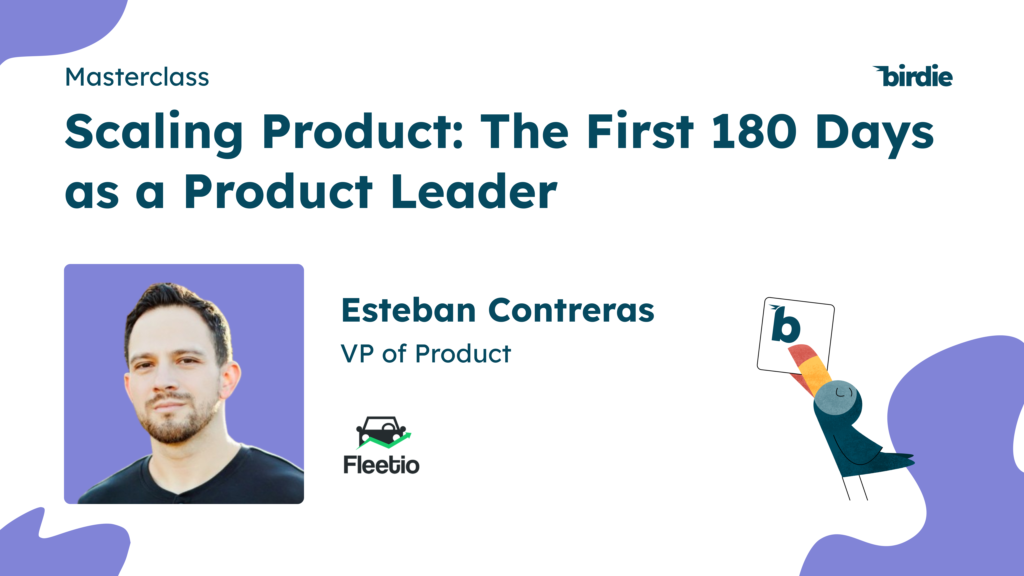
In the ever-evolving landscape of product development, effective leadership can make all the difference between success and stagnation. New product leaders, especially in their first 180 days at a company, face unique challenges and opportunities. Esteban, a seasoned product leader with a wealth of experience, recently conducted a masterclass where he shared invaluable insights on scaling products and teams in those critical early days. In this blog post, we’ll delve into the key takeaways from Esteban’s masterclass, offering a comprehensive guide for product leaders and aspiring product leaders.
Leading with Context
One of Esteban’s central messages is the importance of leading with context. He highlights the distinctive nature of each company, product, team, and individual within the organization. This context, as he emphasizes, is essential to guide your decision-making. Here are some key points:
- Customer-Centric Approach: As a product leader, your primary focus should be on ensuring that your product helps customers succeed. Building the best product or optimizing processes is essential, but it’s all in service of this ultimate goal.
- Being Evidence-Based: Product leaders should approach decision-making with an evidence-based point of view. This means gathering and analyzing both quantitative and qualitative data to understand the current state, as the evidence that worked in the past may not apply to your current situation.
- Adapting to Unique Context: Recognize that each company, product, team, and individual is unique. As a product leader, you must tailor your approach to fit this unique context. Your values, skills, and leadership style should align with the specific needs of your organization.
Joining the Team
Esteban highlights the importance of joining the team rather than simply dictating orders. He shares a compelling analogy involving soccer superstar Lionel Messi to illustrate his point. Here’s what it means to join the team:
- Collaboration and Relationship-Building: Effective product leadership requires you to connect with your team members, set the pace, and lead by example. Collaboration is key, and you must be an active and empathetic participant in the team’s journey.
- Wearing the Team’s Colors: Just as Messi embraced the identity of his new team, product leaders need to immerse themselves in their team’s culture, values, and objectives. This approach helps build trust, momentum, and a shared sense of purpose.
- Balancing Soft Skills: Product leadership isn’t just about technical know-how; it’s about soft skills too. Developing empathy, effective communication, and the ability to connect with your team are just as crucial as any technical knowledge.
Customer Engagement
Engaging with customers is a cornerstone of successful product leadership. Esteban underlines the significance of actively listening to customer feedback. Here’s what you need to know:
- Listening Actively: Engage with customers through a variety of channels, including user feedback, surveys, support tickets, and sales calls. Listen actively to what they’re saying, as it can provide valuable insights into what the company needs most.
- Prioritizing Real Problems: As a product leader, your role is to prioritize and focus on solving real problems for your customers. You need to discern what matters most at any given time and address it effectively.
- Evidence-Based Decision-Making: Once you’ve collected customer feedback, use it as evidence to guide your decision-making. Decipher what is true and what isn’t, what’s working, and what isn’t, and make informed choices.
Handling High Performers as a Product Leader
Dealing with high-performing individuals on your team can be challenging. Esteban acknowledges this and offers insights into effective management. Here’s what you need to consider:
- Team Composition: While it might be intimidating to manage a team of stars, Esteban emphasizes that having high performers is an asset. High-performing individuals are often highly skilled and motivated, which can benefit the team.
- Focus on Values and Collaboration: As a product leader, your role is to guide, collaborate, and lead, regardless of your team’s composition. Focus on shared values and the collective objective of improving the product.
- Building Strategic Muscle: Product leaders need to build their strategic muscles. Decision-making, collaboration, and creating a shared vision are all part of this process.
Esteban’s masterclass offers a comprehensive guide for product leaders in their first 180 days at a new company. Leading with context, joining the team, engaging with customers, and managing high-performing individuals are all essential aspects of effective product leadership. By following these principles, product leaders can navigate the complexities of scaling products and teams while ensuring that their focus remains on customer success and business growth. In the dynamic world of product development, these insights are invaluable for those aiming to make a lasting impact.
Feedback Analytics Platform for a better product management strategy
Birdie helps product-centric companies better understand customers at scale to create product strategies to increase acquisition, conversion, and retention.
Related Posts
4 Steps to Leverage Qualitative Data to Improve Customer Satisfaction and Reduce Support Cost
After multiple iterations of our own methodology to help our customers increase their customer satisfaction [...]
Leveraging Customer Feedback Analytics to Enhance Customer Experience in FinTech
Leveraging Customer Feedback Analytics to Enhance Customer Experience [...]
Navigating the Path to SaaS Success: Insights from Henrique at Bill.com
In the fast-paced world of Software as a Service (SaaS), success isn’t just about building [...]
Product Leader’s First 180 Days: Insights from Esteban’s Masterclass on Scaling Product and Teams
In the ever-evolving landscape of product development, effective leadership can make all the difference between [...]
Leveraging AI and Behavioral Economics for Community Building and User Engagement
Today it’s really important for businesses to create active online communities and get users involved. [...]
From Product Management to the C-Suite: Navigating Your Path to Leadership
The journey from a product management role to a leadership position in the C-suite is [...]
Building and Scaling Feedback Loops for Effective Product Development
In the dynamic world of product development, feedback is the lifeblood that fuels innovation and [...]
Successful Product Discovery: 4 Key Insights from a Sr. Product Manager at Miro
Successful Product Discovery [...]